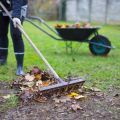Introduction to British Lawn Mower Maintenance
Maintaining a quintessentially British lawn is both an art and a science, deeply rooted in the UK’s gardening traditions. Central to this is the condition of your lawn mower blades. Sharp blades are essential not only for achieving that signature striped effect but also for ensuring the health and resilience of British grass varieties such as perennial ryegrass, fescues, and bent grasses. These species, common throughout the UK, respond best to clean, precise cuts which prevent disease and promote vigorous regrowth. Given the UK’s distinct seasons—marked by cool, damp springs and unpredictable summers—regular blade sharpening becomes a vital part of routine lawn care. Dull blades tear rather than slice grass, leading to frayed tips and increased susceptibility to fungal infections, especially during wet periods. This guide will explore how to sharpen your mower blades using tried-and-tested British methods and readily available UK products, ensuring your lawn remains the pride of the neighbourhood throughout the year.
2. Essential Tools and Recommended UK Products
Before embarking on the task of sharpening your lawn mower blades, it is crucial to assemble the appropriate tools and select reliable products readily available in the UK market. Not only does this ensure effective maintenance, but it also upholds safety and aligns with British standards for garden equipment care. Below is a comprehensive guide to the essential items you will require, along with recommended brands commonly stocked by major retailers such as B&Q and Homebase.
Key Tools and Equipment
- Flat File or Sharpening Stone: A robust flat file (such as those from Draper or Silverline) is ideal for manual blade sharpening, allowing for precise edge control. Alternatively, a sharpening stone provides a finer finish.
- Bench Vice: Securing the blade firmly is vital. Brands like Stanley or Irwin offer reliable bench vices suitable for home use.
- Wire Brush: For removing debris and rust prior to sharpening, consider brushes from Rolson or Wickes.
Safety Gear
- Protective Gloves: Heavy-duty gloves (e.g., Briers or Mechanix) help prevent accidental cuts during handling.
- Safety Glasses: Eye protection from brands like DeWalt or JSP ensures safe operation while filing.
Lubricants and Cleaning Agents
- Multi-Purpose Lubricant: After sharpening, use WD-40 or 3-IN-ONE oil to protect against corrosion.
- Mild Detergent: For cleaning, Fairy Liquid diluted with water effectively removes grass sap and dirt.
At-a-Glance: Recommended UK Products
| Tool/Accessory | Recommended Brand | Where to Buy |
|---|---|---|
| Flat File | Draper, Silverline | B&Q, Homebase |
| Bench Vice | Stanley, Irwin | B&Q, Homebase |
| Wire Brush | Rolson, Wickes | B&Q, Homebase |
| Protective Gloves | Briers, Mechanix | B&Q, Homebase |
| Safety Glasses | DeWalt, JSP | B&Q, Homebase |
| Lubricant Oil | WD-40, 3-IN-ONE | B&Q, Homebase |
A Note on Sourcing Locally
Sourcing your tools from trusted British retailers not only guarantees quality but also ensures compatibility with local safety standards. Both B&Q and Homebase offer an extensive range of gardening tools and maintenance products tailored for UK lawns and climate conditions. By opting for these recommended brands and outlets, you can be confident in both performance and durability as you proceed with lawn mower blade maintenance.
![]()
3. Preparing Your Lawn Mower Safely
Before undertaking any maintenance on your lawn mower, safety should be your utmost priority. British lawn mowers, whether petrol or electric, require specific steps to ensure both operator and equipment remain protected throughout the sharpening process. Follow these step-by-step precautions to create a safe environment tailored to UK mower models.
Step 1: Disconnect the Power Source
For electric mowers commonly used in the UK, always unplug the machine from the mains or remove the battery if it’s a cordless model. For petrol mowers, disconnect the spark plug wire to prevent accidental starting. This simple measure greatly reduces the risk of injury during blade removal or inspection.
Step 2: Clear and Prepare Your Workspace
Select a flat, stable surface—such as a garage floor or patio area—where you can work comfortably. Remove garden debris and tools that may cause tripping hazards. Adequate lighting is essential for visibility when handling sharp blades.
Step 3: Secure the Mower
Stabilise your mower by placing wooden chocks or bricks around the wheels. If your model has a folding handle, ensure it is locked in place to avoid sudden movement. Positioning the mower on its side (with the air filter facing up for petrol models) prevents oil or fuel leaks and allows easy access to the blade.
Step 4: Wear Protective Equipment
Always don sturdy gardening gloves and safety glasses before beginning work. These protect against sharp edges, flying debris, and accidental contact with cleaning agents or lubricants commonly used in British maintenance routines.
Step 5: Keep Manufacturer’s Instructions at Hand
Refer to your lawn mower’s manual for model-specific guidance—many UK brands provide detailed safety checklists relevant to their products. Adhering to these recommendations ensures compliance with local safety standards and helps preserve your warranty.
By following these thorough precautions, you will establish a secure foundation for sharpening your lawn mower blades using trusted British methods and products.
4. Sharpening Process Using British Techniques
Removing the Blade Safely
Begin by ensuring your lawn mower is switched off and disconnected from the mains supply or spark plug, in accordance with British safety standards (BS EN ISO 12100). Carefully tilt the mower onto its side, making sure the air filter and carburettor face upwards to prevent leaks. Use a spanner or socket wrench to loosen and remove the blade bolt. It is advisable to wear protective gloves throughout this process to comply with Health and Safety Executive (HSE) recommendations.
Inspecting the Blade
Once removed, lay the blade flat on a stable work surface. Inspect both cutting edges for nicks, dents, or excessive wear. Check for any warping along the length of the blade, as per British Standards Institution (BSI) guidelines for garden machinery maintenance. If the blade is excessively damaged or thinner than 3mm at any point, consider replacing it to maintain optimal performance and safety.
| Inspection Criteria | British Standard Reference | Action Required |
|---|---|---|
| Nicks/Dents > 3mm | BS EN 836:2012 | Sharpen if minor; replace if severe |
| Bent/Deformed Blade | BS EN ISO 5395-1:2013 | Replace immediately |
| Corrosion Present | BS EN ISO 9227:2017 | Clean or replace if extensive |
Sharpening Techniques
Secure the blade in a vice with the cutting edge facing upwards. Using a flat file or a bench grinder—both readily available from reputable UK suppliers such as Screwfix or B&Q—file along the original bevel angle (typically 30 degrees) in one direction only, following BS EN ISO 5395-2 guidance for safe sharpening. Avoid creating a razor-sharp edge; a slight bluntness reduces chipping and increases durability on British lawns, which often contain hidden debris.
Recommended Products for Sharpening (UK)
| Product Type | Popular Brand (UK) | Description |
|---|---|---|
| Flat File | Draper Tools | Carbon steel file, ideal for hand-sharpening blades |
| Bench Grinder | Titan | Electric grinder for faster, uniform sharpening |
| PPE (Gloves/Goggles) | Screwfix Basics | Protective equipment complying with HSE standards |
Blade Balancing Check (Optional but Recommended)
After sharpening, place the blade on a balancer or hang it on a nail through its centre hole. If one side dips lower than the other, remove small amounts of material from the heavier side until balanced. This step ensures smooth operation and prevents undue strain on your mower’s motor as recommended by BSI best practices.
5. Reassembly and Maintenance Best Practices
Reattaching the Blades Securely
Once your lawn mower blades have been sharpened, it’s crucial to reattach them correctly to ensure optimal performance and safety. Begin by aligning the blade with the central shaft, paying close attention to the correct orientation as indicated in your mower’s manual. Use a torque wrench to tighten the bolt to the manufacturer’s recommended setting—this is especially important for mowers common in the UK, such as those from Flymo or Mountfield. Over-tightening can strip threads, while under-tightening may allow the blade to come loose during operation.
Checking and Adjusting Mower Balance
After reassembly, always check the balance of your mower blade—a vital step often overlooked. An imbalanced blade can cause excessive vibration, increased wear on bearings, and uneven cuts. To do this, place the blade on a simple balancer or even a large nail fixed horizontally in a vice. The blade should rest evenly; if one side dips, file a small amount from that end until balance is achieved. This procedure is standard practice across British households and professional gardening services alike.
Corrosion Prevention: Recommended UK Products
British weather is notoriously damp, making corrosion prevention an essential aspect of maintenance. Once your blades are back in place, wipe them down with a rag lightly moistened with a reputable product such as WD-40 or 3-IN-ONE Multi-Purpose Oil—both readily available at UK hardware stores like B&Q or Homebase. For long-term protection, consider applying a thin coat of Castrol Rustilo or Hammerite Waxoyl, both trusted by UK gardeners for their effectiveness against rust and moisture. Regular application after each sharpening session will significantly extend your mower’s service life.
Final Inspection and Safety Checks
Before starting your mower, conduct a thorough visual inspection to ensure all fastenings are secure and no tools have been left inside the housing. Engage the safety mechanisms and start the mower briefly to listen for abnormal sounds or vibrations—address any issues before resuming regular use.
Ongoing Maintenance Habits
Incorporate these best practices into your routine maintenance schedule, particularly during peak mowing seasons in Britain’s spring and summer months. Regular sharpening, balancing, and rust prevention not only improve cut quality but also safeguard your investment in reliable British-made equipment.
6. Seasonal Tips and Sustainable Disposal
Knowing When to Sharpen in the British Climate
The temperate and often damp British climate means lawns grow vigorously from spring through autumn, with growth peaking in late spring and early summer. For optimal results, inspect your mower blades at the start of each mowing season (typically March or April). In most UK gardens, sharpening blades two to three times a season is sufficient—early spring, midsummer, and before the final autumn cut. However, if you mow more frequently or tackle rough terrain, check for dullness after every 20 hours of use. Signs that it’s time to sharpen include torn grass tips, uneven cuts, or increased engine strain.
Sustainable Disposal and Recycling of Old Blades
When your mower blades become too worn or damaged for further sharpening, responsible disposal is essential. Most local councils across the UK provide metal recycling facilities at household waste recycling centres (HWRCs). Before visiting, contact your council or check their website for specific guidance on metal acceptance and any preparation required, such as cleaning off residual grass or oil. Some councils also offer kerbside collection for small metal items—always place blades in a sturdy container or wrap them securely to prevent injuries. By recycling old blades, you help reduce landfill waste and support local sustainability initiatives.
Additional Eco-Friendly Tips
If replacing your blade, consider purchasing British-made options crafted from recycled steel or brands committed to sustainable manufacturing practices. Where possible, reuse or repurpose old blades for garden markers or creative DIY projects—just ensure all sharp edges are blunted for safety.
Summary
Sharpening and disposing of lawn mower blades in line with British best practice not only extends equipment life but also supports environmental responsibility within your community.


